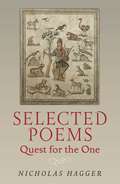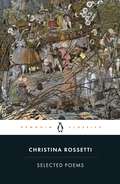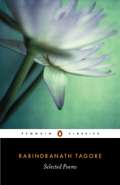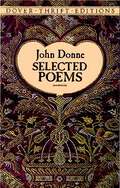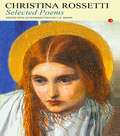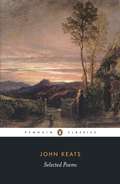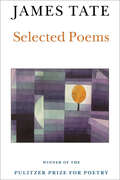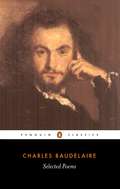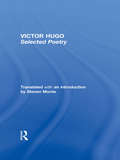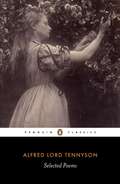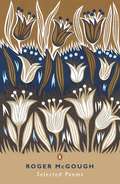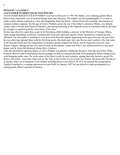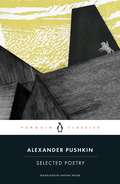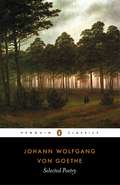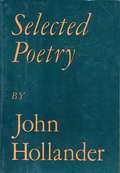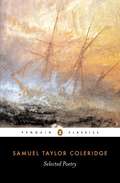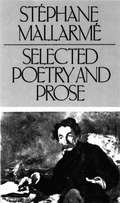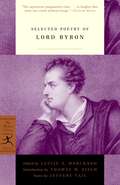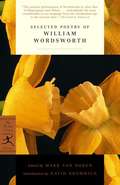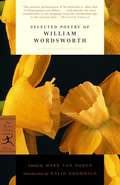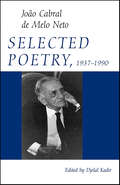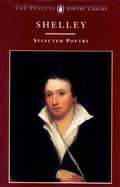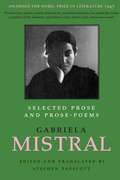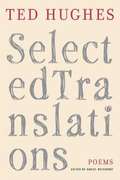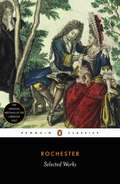- Table View
- List View
Selected Poems: Quest for the One
by Nicholas HaggerThese poems serve as an introduction to Nicholas Hagger&’s poetic works, which include nearly 1,500 poems, more than 300 classical odes, two poetic epics and five verse plays. They are grouped in two parts which reflect the two aspects of the fundamental theme of world literature outlined in his A New Philosophy of Literature: &‘Quest for the One&’ and &‘Follies and Vices&’. They present a quest for Reality along with moments of heightened consciousness in which the universe is seen as a unity, and condemn social follies and over 220 vices in terms of an implied virtue. This selection of poems combines image and statement in the reconciling Universalist manner, and in different poems blends Romantic search and organic form with classical social attitudes, verbal precision and architectural structure. The poems cover five decades and include extracts from &‘The Silence&’, which describes Freeman&’s quest for Reality in Modernist style, &‘Archangel&’ (a reflection on Communism following visits to China and the Soviet Union), poems written during a Dark Night of the Soul, glimpses of illumination and poems of social satire. There are also extracts from Hagger's verse plays. As can be seen from his &‘A Metaphysical in Marvell&’s Garden&’ Hagger derives his inspiration from the 17th-century Metaphysical poets and seeks to unite the later Augustan and Romantic traditions. This selection offers a chance to reappraise a poet whose material, accomplished technique and reconciling sensibility places him in the forefront of poets writing today.
Selected Poems: Rossetti (Fyfield Bks.)
by Christina RossettiThis new selection of Rossetti's poems brings together works by one of the most significant nineteenth-century English poets. It includes an illuminating introduction, a chronology of Rossetti's life and works, and explanatory notes.
Selected Poems: Selected Poems (Collins Classics Ser.)
by Rabindranath TagoreThe poems of Rabindranath Tagore (1861-1941) are among the most haunting and tender in Indian and in world literature, expressing a profound and passionate human yearning. His ceaselessly inventive works deal with such subjects as the interplay between God and the world, the eternal and transient, and with the paradox of an endlessly changing universe that is in tune with unchanging harmonies. Poems such as 'Earth' and 'In the Eyes of a Peacock' present a picture of natural processes unaffected by human concerns, while others, as in 'Recovery - 14', convey the poet's bewilderment about his place in the world. And exuberant works such as 'New Rain' and 'Grandfather's Holiday' describe Tagore's sheer joy at the glories of nature or simply in watching a grandchild play.
Selected Poems: Selected Poems (Dover Thrift Editions: Poetry)
by John DonneConsidered by many critics the foremost English "metaphysical" poet, John Donne (1572–1631) earned renown for both sacred and secular verse, his love poems in the latter genre ranking among his most original and popular works. Brilliant and wide-ranging, Donne's verse is distinguished by its passion, insight, and inspired use of striking metaphors or "conceits." This volume contains a rich selection of the poet's best work, including, from the Songs and Sonnets: "The Good Morrow," "The Canonization," "The Relic," and "A Valediction: Forbidding Mourning"; from the Elegies: "On His Mistress" and "To His Mistress Going to Bed"; a selection from the Holy Sonnets (including "Death Be Not Proud"); "Good Friday. 1613. Riding Westward," "Hymn to God My God, in My Sickness" and many more.
Selected Poems: Selected Poems (Fyfield Books)
by Christina RossettiFirst published in 2002. Routledge is an imprint of Taylor & Francis, an informa company.
Selected Poems: Selected Poems (Macmillan Collector's Library #188)
by John KeatsOver the course of his short life, John Keats (1795-1821) honed a raw talent into a brilliant poetic maturity. By the end of his brief career, he had written poems of such beauty, imagination and generosity of spirit, that he had - unwittingly - fulfilled his wish that he should ‘be among the English poets after my death’. This wide-ranging selection of Keats’s poetry contains youthful verse, such as his earliest known poem ‘Imitation of Spenser’; poems from his celebrated collection of 1820 - including ‘Lamia’, ‘Isabella’, ‘The Eve of St Agnes’, ‘Ode to a Nightingale’ and ‘Hyperion’ - and later celebrated works such as ‘La Belle Dame sans Merci’. Also included are many poems considered by Keats to be lesser work, but which illustrate his more earthy, playful side and superb ear for everyday language.
Selected Poems: Selected Poems 1990 - 2010 (Wesleyan Poetry Series)
by James TateThe Pulitzer Prize-winning collection of exquisite poems by &“a poet of mad wit and stunning anecdote. Tate is now in the fullness of his powers&” (Julian Moynahan, author of Sisters and Brothers). Selected Poems, James Tate&’s award-winning collection and his first British publication, gathers work from nine previous books, from the Lost Pilot which was a Yale Younger Poets selection in 1967, through his 1986 collection Reckoner. He is a most agile poet in a precarious world. Life is alarming and absurd, but properly considered that absurdity reveals, often with laughter, the something else by which we live. The poems are about our world, our wrecked, vexed love for it. Tate has been described as a surrealist. If that is what he is, his surrealism issues in a vision of a world delivered back to itself by his unillusioned subversion and candor. &“This volume performs a valuable service by drawing together the best of Tate&’s work from many individual collections, some of them now quite rare. It allows us finally to take the measure of his genius: passionate, humane, funny, tragic, and always surprising and mind-delighting. Not unexpectedly, it confirms his standing as one of the finest voices of his generation&” —John Ashbery, Pulitzer Prize-winning poet &“He has the rare ability to be very, very funny on the page.&” —The New York Times Book Review
Selected Poems: Selected Poems And Prose
by Charles-Pierre BaudelaireThe poems of Charles Baudelaire are filled with explicit and unsettling imagery, depicting with intensity every day subjects ignored by French literary conventions of his time. 'Tableaux parisiens' portrays the brutal life of Paris's thieves, drunkards and prostitutes amid the debris of factories and poorhouses. In love poems such as 'Le Beau Navire', flights of lyricism entwine with languorous eroticism, while prose poems such as 'La Chambre Double' deal with the agonies of artistic creation and mortality. With their startling combination of harsh reality and sublime beauty, formal ingenuity and revolutionary poetic language, these poems, including a generous selection from Les Fleurs du Mal, show Baudelaire as one of the most influential poets of the nineteenth century.
Selected Poems: Selected Poetry In French And English (Fyfield Books)
by Victor HugoThis generous, varied selection of poems by one of France's best-loved and most reviled poets is presented with facing originals, detailed notes, and a lively introduction to the author's life and work. Steven Monte presents more than eighty poems in translation and in the original French, taken from the earliest poetic publications of the 1820's, through collections published during exile, to works published in the years following Hugo's death in 1883. The introduction provides helpful background information about Hugo's life and work, the selection, and what is involved in translating a poet whose effortless rhymes are central to the poetry's power. Detailed notes at the back of the volume offer information about the poems and their publishing and historical contexts. This is an ideal introduction to a poet whose work, for all its renown, remains for Anglophone readers undiscovered.
Selected Poems: Tennyson
by Alfred Lord TennysonTennyson's poetry epitomizes the Victorian age, for which he became a spokesman. His finest poems are often steeped in a sensuous melancholy, as in Maud, or are chivaric, heroic and allegorical, as in The Lady of Shalot and Morte d'Arthur.
Selected Poems: The Selected Poems Of Roger Mcgough
by Roger McGoughAn updated selection of Roger McGough's finest, best-loved verse. The complete span of McGough's writing, from the 1960s to the new millennium, is represented. 'McGough's trademarks: the craft worn as lightly as the crown, the jokes that are something more, the underlying heartache, the acute sense of the way time slips away' Ian McMillan, Poetry Review 'McGough has done for poetry what champagne does for weddings' Time Out
Selected Poetry
by Alexander Pushkin Antony WoodPushkin's The Bronze Horseman, based on the statue of Peter the Great in Saint Petersburg and the great flood of 1824, is widely considered to be his most successful narrative poem, the second most famous poem in Russian literature after his Eugene Onegin, and notoriously difficult to translate. One of the most influential works in Russian literature, it will appeal to readers of Dostoyevsky's The Double, Andrei Biely's Petersburg, Anna Akhmatova's poetry, and the works of Nikolai Gogol. <p><p>This new translation, described by Robert Chandler as "truly wonderfull," is accompanied here by Pushkin's greatest shorter verses. They range from lyric poetry to narrative verse based on traditional Russian stories of enchanted tsars and magical fish. Together, they show the dazzling range and achievement of Russia's greatest poet.
Selected Poetry
by Alexander PushkinWINNER OF THE READ RUSSIA PRIZE 2020Alexander Pushkin established what we know as Russian literature. This collection includes his strongly personal lyric verse, which springs spontaneously from his everyday life - his numerous loves, his exile, his hectic life in St Petersburg - while the narrative poems here, from exotic Southern tales to comic parodies and fairy tales of enchanted tsars, display his endless ability to surprise. His landmark work The Bronze Horseman, with its ghostly central figure of Peter the Great, holds the meaning of all Russian history. Antony Wood's translations reveal the variety, inventiveness and perfection of Pushkin's verse.
Selected Poetry
by Goethe'Shall I embrace you, must I let you go? Again you haunt me: come then, hold me fast!'Goethe viewed the writing of poetry as essentially autobiographical and the works selected in this volume represent over sixty years in the life of the poet. In early poems such as 'Prometheus' he rails against religion in an almost ecstatic fervour, while 'To the Moon' is an enigmatic meditation on the end of a love affair. The Roman Elegies show Goethe's use of Classical metres in homage to abcient Rome and its poets, and 'The Diary' , supressed for more than a century, is a narrative poem whose eroticism is unusually combined with its morality. Arranged chronologically, David Luke's verse translations are set alonjgside the German orginals to give a picture of Goethe's poetic development. This edition also includes an introduction and notes placing the poems in the context of the poet's life and times.
Selected Poetry
by John Hollander"Perfection is a rare accomplishment, particularly in American poetry, and the perfection of much of Hollander's work makes it essential reading for anyone who genuinely cares for the craft of poetry. But in our fallen world we seem fated to value power of perfection, and John Hollander's poetry has shown a visionary power just often enough to secure him a place as one of the major figures of our moment."Vernon Shetley, The New Republic
Selected Poetry
by Samuel ColeridgeLiving in a revolutionary age, Coleridge's poetry was written in a spirit of moral and emotional inquiry into the absolutes of the human condition. He is best known for his visionary poetry ('Kubla Khan') and his ballads ('The Rime of the Ancient Mariner'), but he used and transformed a variety of verse forms, from the sonnet to the conversation poem, on subjects as diverse as nature, love, and politics. This selection calls attention to the range of Coleridge's work, its strong autobiographical content,and its artistic development throughout his career. The old chronological form has been abandoned and the poems are organised according to genre, with each section displaying its own individual development in craft and theme.
Selected Poetry and Prose
by Stephane MallarmeThe essential work of Mallarmé, collected in a bilingual French and English edition. Selected Poetry and Prose of Stéphane Mallarmé presents what can be considered the essential work of the renowned "father of the Symbolists." Mallarmé's major elegies, sonnets, and other verse, including excerpts from the dialogue "Hériodiade," are all assembled here with the French and English texts en face. Also included (not bilingually) are the visual poem "Dice Thrown Never Will Annul Chance" and the drama "Igitur," as well as letters, essays, and reviews. Although his primary concern was with poetry, the aesthetics of Stéphane Mallarmé (1842-98) has touched all the arts. During the last twenty years of his life, his Paris apartment was a major literary gathering place. Every Tuesday evening, standing beneath the portrait of himself by his friend Edouard Manet, the poet addressed reverent gatherings which included at various times Paul Valery and André Gide, among many others. The American painter James Whistler was influenced by these "Mardis," and one of the best-known poems in the present collection, "The Afternoon of a Faun," inspired Claude Debussy's famous musical composition. In translation, the subtle and varied shades of Mallarmé's oeuvre may best be rendered by diverse hands. Editor Mary Ann Caws, the author of books on René Char, Robert Desnos, and various aspects of modern French writing, has brought together the work of fourteen translators, spanning a century, from the Symbolists and the Bloomsbury group (George Moore and Roger Fry) to Cid Corman, Brian Coffey, and other contemporary poets and writers.
Selected Poetry of Lord Byron (Modern Library Classics)
by Leslie A. MarchandPoet, celebrity, and revolutionary, Lord (George Gordon) Byron was one of the most influential and controversial figures of the first half of the nineteenth century, his distinctive, deeply felt work comprising one of the enduring high points of Romantic literature. From “Manfred,” with its evocation of the figure that came to be called the “Byronic hero,” to the melancholy “Childe Harold,” to the satirical masterpiece “Don Juan” (presented here in judiciously selected form), this Modern Library Paperback Classic includes all of the essential Byron.
Selected Poetry of William Wordsworth
by Mark Van Doren William WordsworthSelected Poetry of William Wordsworth represents Wordsworth's prolific output, from the poems first published in Lyrical Ballads in 1798 that changed the face of English poetry to the later works. Wordsworth's poetry is celebrated for its deep feeling, its use of ordinary speech, the love of nature it expresses, and its representation of commonplace things and events. As Matthew Arnold notes,[Wordsworth's poetry] is great because of the extraordinary power with which [he] feels the joy offered to us in nature, the joy offered to us in the simple elementary affections and duties.
Selected Poetry of William Wordsworth: Selected And Prepared For Use In Schools And Classes, From Hudson's Text-book Of Poetry (Modern Library Classics)
by Mark Van Doren William Wordsworth David BromwichSelected Poetry of William Wordsworth represents Wordsworth's prolific output, from the poems first published in Lyrical Ballads in 1798 that changed the face of English poetry to the late "Yarrow Revisited." Wordsworth's poetry is celebrated for its deep feeling, its use of ordinary speech, the love of nature it expresses, and its representation of commonplace things and events. As Matthew Arnold notes, "[Wordsworth's poetry] is great because of the extraordinary power with which [he] feels the joy offered to us in nature, the joy offered to us in the simple elementary affections and duties."From the Trade Paperback edition.
Selected Poetry, 1937–1990 (Wesleyan Poetry Series)
by João MeloThis bilingual anthology brings together a representative selection from more than a half century of this distinguished Brazilian poet's lifetime work. Along with previously translated poems are many others in English for the first time. The remarkable group of poets and translators includes Elizabeth Bishop, Alastair Reid, Galway Kinnell, Louis Simpson, and W. S. Merwin.
Selected Poetry: Poems
by Isabel Quigly Percy ShelleySHELLEY'S WORK HAS BEEN CRITICIZED FOR ITS DIDACTICISM AND UNDISCIPLINED EMOTIONALISM. BUT ESSENTIALLY HE WAS A POET OF IDEAS AND IN HIS SEARCH FOR TRUTH AND ORIGINAL HUMAN PERFECTION, SHELLEY WAS INSPIRED AS MUCH BY THE GREEK POETS AND PHILOSOPHERS, PARTICULARLY PLATO, AS BY THE RADICALISM OF HIS OWN AGE. ABOVE ALL, HIS GREAT GIFT WAS HIS LYRICISM AND HIS VERSE COMES AS NEAR TO MUSIC AS POETRY CAN.
Selected Prose and Prose-Poems
by Stephen TapscottThe first Latin American to receive a Nobel Prize for Literature, the Chilean writer Gabriela Mistral (1889-1957) is often characterized as a healing, maternal voice who spoke on behalf of women, indigenous peoples, the disenfranchised, children, and the rural poor. She is that political poet and more: a poet of philosophical meditation, self-consciousness, and daring. This is a book full of surprises and paradoxes. The complexity and structural boldness of these prose-poems, especially the female-erotic prose pieces of her first book, make them an important moment in the history of literary modernism in a tradition that runs from Baudelaire, the North American moderns, and the South American postmodernistas. It's a book that will be eye-opening and informative to the general reader as well as to students of gender studies, cultural studies, literary history, and poetry.
Selected Translations
by Ted HughesThe late, great poet's version of poems ancient and modern. Known (with Philip Larkin) as the most distinctly English of the postwar British poets, Ted Hughes was a boundlessly curious reader and translator of poetry from other languages. This generous selection of his translations at once rounds out the publication of his major work and gives us a fresh view of his poetic achievement. In 1965, Hughes, already famous in Britain, founded the journal Modern Poetry in Translation, and a number of the translations here are of poems by his contemporaries: the Israeli Yehuda Amichai, the Hungarian János Pilinszky, and the Serbian Vasko Popa. At the same time, Hughes was forever in search of older precursors, whether Homer, Lorenzo de' Medici, or the authors of Sir Gawain and the Green Knight and The Tibetan Book of the Dead, and his translations of them deepen our sense of his interest in pagan ritual and esoteric religion. These two strains of his work as translator were brought together late in his career, when, with supple and radiant versions of Ovid's Metamorphoses, Aeschylus' Oresteia, and Euripides' Alcestis--all amply represented here--he established himself as one of the foremost interpreters of the classics in English. Selected Translations is a vital addition to the Hughes oeuvre.
Selected Works
by Earl of RochesterThe brightest star at the court of King Charles II, John Wilmot, Earl of Rochester (1647-80), lived a life of reckless debauchery and sexual adventuring that led to his death at the age of thirty-three - described by Samuel Johnson as having 'blazed out his youth and health in lavish voluptuousness'. Rochester was also one of the wittiest and most complex poets of the seventeenth century, writing comic verse, scurrilous satires and highly explicit erotica - from the bawdy self-portrait in 'The Maimed Debauchee' and the tender passion of 'Absent from thee I languish still' to the comic world-weariness of 'Upon Nothing' and 'A Satyr against Mankind', which mocks human follies. With endless literary disguises, rhymes and alliteration, humour and humanity, Rochester's poems hold up a mirror to the extravagances and absurdities of his age.
